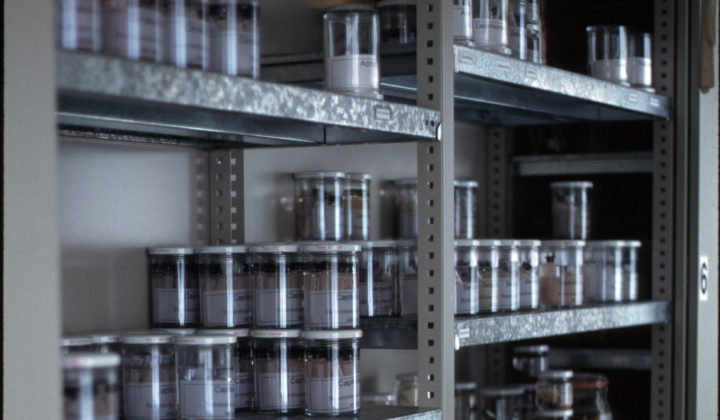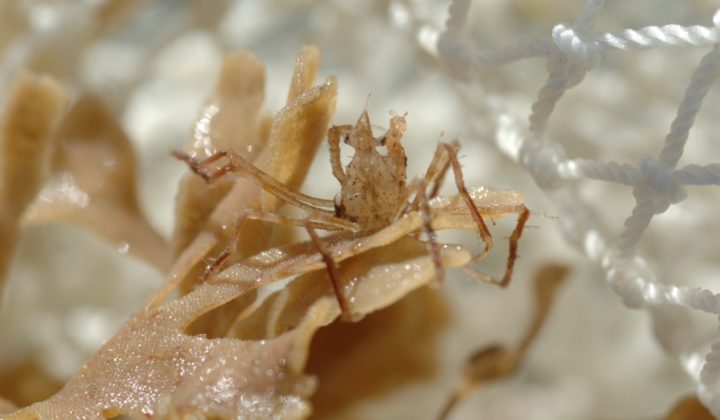Marine Zoology
Marine Invertebrates II
The section Marine Invertebrates II is responsible for the curation of a large part of Senckenberg’s collections of recent marine invertebrates: Plathyhelminthes, Nemertea, Aschelminthes, Sipuncula, Echiura, Annelida, Chaetognatha, Echinodermata and Hemichordata.
The plathyhelminths, annelids, and echinoderms represent valuable collections including numerous type specimens. The metadata of all collections have been transferred to the database SeSam/Aquila with financial support from the Walter & Erika Datz-Foundation and the German Research Foundation (DFG; Fi 433/12-1), and are available for online research. Research of the section is focused on the taxonomy, systematics, morphology, and biogeography of Polychaeta.
The Polychaeta form a group of the phylum Annelida and comprise with its approximately 10000 currently known species one of the most diverse marine animal taxa besides Crustacea and Mollusca. They occur in great diversity in all marine habitats from the intertidal down to the deep-sea, from seagrass meadows to hot vents. Polychaetes do not only show a wide variety of morphological adaptations to their habitat and mode of life, they are also able to cope with advertent living conditions in such extreme habitats as hot vents and cold seeps. These habitats are characterized by high temperature and dissolved toxic substances like sulfur and heavy metals. In suitable habitats, polychaetes often occur in large densities producing important biomass, especially in soft sediments, e.g. Arenicola marina at our North Sea coast.
Polychaetes are among the most common marine animals and therefore an important element of the marine food web. Many of them live on detritus, thus recycling nutrients, while they are preyed upon by fish, other invertebrates, and even birds, e.g. on tidal flats. They also play an important role in bioturbation of the sediment, as bioindicators, fouling species on ships, and harbor facilities, as neozoa, i.e. species distributed by man, and as pests in oyster farms. They are the subject of physiological and developmental research. Last but not least polychaetes grown in aquacultures are of economic importance as bait for fishing. In the beginning of the 90’s, aquaculture of polychaetes in Maine (USA) produced an annual value of ca. $3,5 million and thus represented an important income for fisheries in this region next to lobster, clams, and fish.
Research on systematics and diversity of polychaetes is of basic importance not only for systematics itself, but also for other fields of research such as ecology and conservation. Moreover, polychaetes play an important role in the deep-sea, a global habitat that has received much attention during recent years.
Besides the curation of the above-mentioned collections, the section has taken over a number of other institutional obligations, like the technical and organizational responsibility for the scanning electron microscope.
The Section Marine Invertebrates 2 houses one of the most comprehensive libraries worldwide comprising contributions to research on Annelida, Polychaeta with respect to taxonomy, systematcs, evolution, biology and ecology.
The Section also houses the World Register of Polychaete Species (WORPS), a compilation of handwritten card files stored as pdfs which provide a comprehensive overview of names of polychaete taxa published in the scientific literature. These files are not only a register of taxa but additional information is included, e.g. on the validity of names, synonymies, detailed literature references (incl. page numbers and figures) and detailed information on geographic and depth distribution of species, which has been collated from the respective references. Thus, information in WORPS complements and partly exceeds information provided for Annelida, Polychaeta in WORMS (World Register of Marine Species).
This register was started in 1952 by Dr. Gesa Hartmann-Schröder and was maintained and expanded by her and her technical staff until her retirement in 1994. She then passed it on to Dr. Dieter Fiege, who had started to study taxonomy and systematics of polychaetes at the Senckenberg in Frankfurt am Main as head of the section Marine Invertebrates 2 in 1990. Together with Dr. Ruth Barnich they continued updating this register until about 2010. Around that time it became too difficult to follow-up the ever increasing number of publications on taxonomy and systematics of polychaetes with the resources available in the section.
The card files of WORPS are handwritten by people, who actively contributed to it. Digital recognition of the different handwritings proved unsuccessful and it was decided to simply scan the cards and save them as pdf-files. These files are organized as folders according to families, subfamilies and genera similar to the original card catalogue. Some of the pdf files comprise more than one page, depending on the research interest and information published for the respective species. For a number of families and many genera additional information is included, e.g. definitions and type species of genera and identification keys. Among the citations listed for each species those underlined in red contain at least a minimum of taxonomic information. In cards originating from the early years of WORPS, citations are represented by the numbers given in Olga Hartman’s bibliography of polychaetous annelids (Hartman 1951).
WORPS can be consulted by polychaete researchers. Please send the respective request to Dr. Dieter Fiege. —dieter.fiege@senckenberg.de
Acknowledging WoRPS
The use of WORPS should be acknowledged in manuscripts with the following citation:
Hartmann-Schröder, G., Barnich, R. & Fiege, D. (2023): World Register of Polychaete Species (WORPS)











